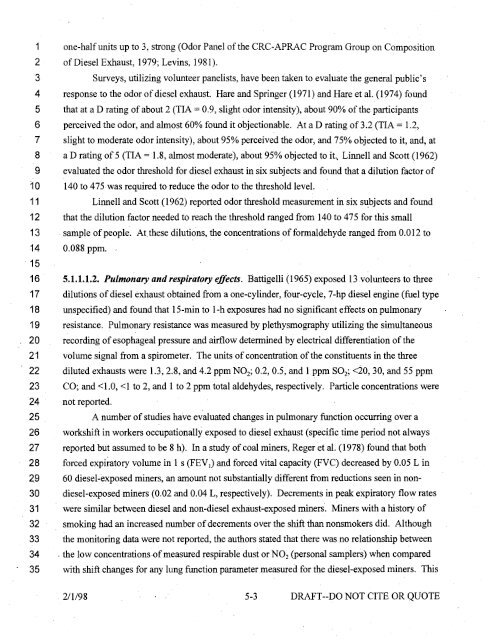Health Assessment Document for Diesel Emissions - NSCEP | US ...
Health Assessment Document for Diesel Emissions - NSCEP | US ...
Health Assessment Document for Diesel Emissions - NSCEP | US ...
Create successful ePaper yourself
Turn your PDF publications into a flip-book with our unique Google optimized e-Paper software.
1 one-half units up to 3, strong (Odor Panel ofthe CRC-APRAC Program Group on Composition<br />
2 of <strong>Diesel</strong> Exhaust, 1979; Levins, 1981 ).<br />
3 Surveys, utilizing volunteer panelists, have been taken to evaluate the general public's<br />
4 response to the odor of diesel exhaust. Hare and Springer ( 1971) and Hare et al. ( 197 4) found<br />
5 that at aD rating of about 2 (TIA = 0.9, slight odor intensity), about 90% of the participants<br />
6 perceived the odor, and almost 60% found it objectionable. At aD rating of 3.2 (TIA = 1.2,<br />
7 slight to moderate odor intensity), about 95% perceived the odor, and 75% objected to it, and, at<br />
8 aD rating of 5 (TIA = 1.8, almost moderate), about 95% objected to it.. Linnell and Scott (1962)<br />
9 evaluated the odor threshold <strong>for</strong> diesel exhaust in six subjects and found that a dilution factor of<br />
1 0 140 to 4 7 5 was required to reduce the odor to the threshold level.<br />
11 Linnell and Scott (1962) reported odor threshold measurement in six Sll;bjects and fotmd<br />
12 that the dilution factor needed to reach the threshold ranged from 140 to 475 <strong>for</strong> this small<br />
13 sample of people. At these dilutions, the concentrations of <strong>for</strong>maldehyde ranged from 0. 012 to<br />
14 0.088 ppm. .<br />
15<br />
16 5.1.1.1.2. Pulmoirary and respiratory effects. Battigelli (1965) exposed 13 volunteers to three<br />
17 dilutions of diesel exhaust obtained from a one-cylinder, four-cycle, 7-hp diesel engine (fuel type<br />
18 unspecified) and found that 15-min to 1-h exposures had no significant effects on pulmonary<br />
19 resistance. Pulmonary resistance was measured by plethysmography utilizing the simultaneous<br />
20 recording of esophageal pressure and airflow determined by electrical differentiation of the<br />
21 volume signal from a spirometer. The units of concentration of the constituents in the three<br />
22 diluted exhausts were 1.3, 2.8, and 4.2 ppm N0 2 ; 0.2, 0.5, and 1 ppm S0 2 ;















